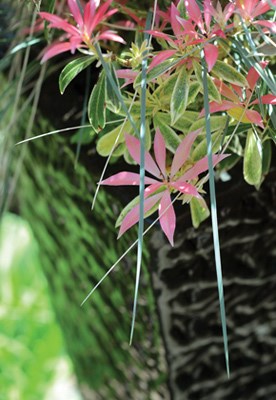TODAY'S ever decreasing property sizes are leaving little room for green space, but a small space can be just as beautiful as a big yard, you just have to be a little more creative.
Small lot homeowners should look to growing a container bursting with texture, colour and even food as a way to green up their space. Even if all you have is a patio or balcony, a few pots with annuals for colour, perennials for foliage interest and even a shrub for privacy can add interest and help to cosy-up the space.
Choosing containers for your space should begin with deciding on what the purpose of your container will be. If you want flower colour then choose summer annuals because they will bloom reliably through most of the summer, even in shade. If you want foliage interest instead of flowers, then choose perennials because they provide a broader range of foliage choices, not that there aren't good foliage annuals available. If you want your containers to provide some privacy then choose a tall but narrow growing shrub, bamboo or climbing vine grown on a trellis in the pot. And with the current movement to growing food at home, growing containers full of food-producing plants has never been easier as garden centres ramp up their supply of veggies for the home garden. Some people may not have the time or will to grow a container with live plants, so for the busy lifestyle there are plenty of silk or artificial plants that take no care but look interesting all year.
Regardless of the purpose of your container, always choose a larger container versus picking a smaller one. Large containers add a sense of scale and proportion to a space that small containers cannot. Large containers require less water and they
grow healthier plants because there is more room for root growth. To balance the size of a large container try adding a couple smaller pots around the large container as companions to create floral grouping of sorts.
Today there are so many styles and types of containers that bothering with terra cotta is almost not worth the effort. I like terra cotta but in our wet climate frost cracking is guaranteed if you choose terra cotta for year-round outdoor use. I know that container purists will be offended, but the quality and variety of plastic pots has improved so much over the years that I have as many plastic pots in my garden as I have stone or ceramic pots. Plastic may look cheap to some people but they are easy to clean, they don't crack and they are easy to lift and move around. If you are choosing ceramic pots be sure that they are glazed to prevent frost cracking in winter. Of course, the most durable container for outdoor use is the coloured, painted or textured concrete pot but concrete pots are quite heavy to move around so a more permanent position suits those best.
Many people have asked me about potting up their containers for winter and summer. During winter I use a soil mix with greater porosity than used in summer to allow for better drainage, usually the winter mix has much more perlite. For a summer soil mix in containers I use whatever potting mix flavour of the month is being sold at the garden centres as long as it is light, porous, pH adjusted and includes perlite. Then I add some of my homemade compost at a ratio of 70-80 per cent potting mix and 20-30 per cent compost. The compost, which could be substituted with regular garden soil, provides pH stabilization and prevents the potting mix from drying out too fast. If you're growing veggies in the pot then make your soil mix 50 percent potting mix and 50 per cent compost or soil amender which provides a more robust growing medium for the veggies. When it comes to filling the container with rocks, pieces of Styrofoam or any other type of bottom filling debris there is simply no science to support it. Adding rocks or broken pieces of whatever to the bottom of the pot simply perches the water table above the pieces and denies your plants the full depth of root zone in the pot. Soil may gently run out of the bottom of the pot for the first watering, but shortly thereafter water molecule tension and soil adhesion will hold all of your soil in the pot. Therefore, I recommend filling your containers completely with soil and nothing else.
When it comes to plant selection in containers, individuality is the genesis of creation, so choose plants that move you visually, fragrantly, edibly or spiritually and not what everyone else likes.
Todd Major is a journeyman horticulturist, garden designer, writer, consultant and organic advocate. For advice contact him at stmajor@shaw. ca.



